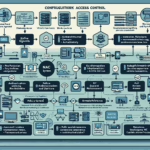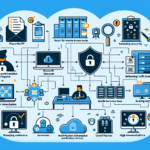Configuring and securing Simple Network Management Protocol (SNMP) for IT infrastructure monitoring is crucial to ensure reliable data collection while minimizing potential security risks. Below is a detailed guide on how to configure and secure SNMP:
1. Understand SNMP Versions
SNMP has three versions:
– SNMPv1: Basic functionality but lacks security features.
– SNMPv2c: Similar to SNMPv1 but adds bulk transfer capabilities. Still lacks encryption.
– SNMPv3: Provides authentication, encryption, and message integrity. Always prefer SNMPv3 for security.
2. Plan the Configuration
Before proceeding with configuration:
– Identify the devices and systems (servers, storage, switches, routers, etc.) you want to monitor.
– Define SNMP communities (for SNMPv2c) or users (for SNMPv3).
– Use read-only access for monitoring. Avoid write permissions unless absolutely necessary.
– Limit SNMP access to specific IP addresses (e.g., your monitoring system).
3. Configure SNMP on Devices
SNMPv2c Configuration
- Set up a community string (e.g.,
MonitoringCommunity) for read-only access. - Restrict access to trusted IP addresses (e.g., your monitoring server).
- Disable SNMPv1 if it is enabled.
SNMPv3 Configuration
- Create SNMPv3 users and assign appropriate privileges.
- Configure authentication (e.g., MD5 or SHA) and encryption (e.g., AES or DES).
- Use strong passwords for SNMPv3 users.
- Specify the access control list (ACL) to allow traffic only from trusted IP addresses.
4. Secure SNMP
General Security Practices
- Disable SNMPv1 and SNMPv2c: Use SNMPv3 exclusively.
- Restrict Access: Configure ACLs or firewalls to allow SNMP traffic only from your monitoring system’s IP address.
- Use Strong Community Strings or Passwords: Avoid default or weak community strings like
publicorprivate. Use long, complex strings. - Encrypt SNMP Traffic: Ensure SNMPv3 is configured with encryption to protect data in transit.
- Limit SNMP Privileges: Use read-only access wherever possible.
Network Security
- Use firewalls to block SNMP traffic from untrusted networks.
- Monitor SNMP ports (default UDP port 161) for unusual activity.
- Disable SNMP if it is not required on a device.
5. Configure the Monitoring Tool
- Ensure the monitoring tool (e.g., Nagios, Zabbix, PRTG, SolarWinds) is configured to use SNMPv3.
- Add the SNMP credentials (community string for v2c or user credentials for v3) in the monitoring tool.
- Set up alerts and thresholds for key metrics like CPU usage, memory, disk space, and network traffic.
6. Test and Validate Configuration
- Perform a test query from your monitoring system to verify SNMP connectivity and functionality.
- Validate that metrics are being collected correctly.
- Confirm that unauthorized devices cannot access SNMP data.
7. Regular Maintenance
- Periodically review SNMP configurations for compliance with security best practices.
- Rotate SNMP community strings or passwords periodically.
- Monitor SNMP logs for suspicious activity.
- Keep firmware and software updated on SNMP-enabled devices.
Example SNMPv3 Configuration on Linux
Here’s an example of configuring SNMPv3 on a Linux system using snmpd:
-
Install SNMP and SNMP utilities:
bash
sudo apt update
sudo apt install snmpd snmp -
Edit the SNMP configuration file (
/etc/snmp/snmpd.conf):
bash
# Example SNMPv3 user configuration
createUser monitoringUser SHA mysecurepassword AES mysecurepassword
rouser monitoringUser -
Restrict access to the monitoring server:
bash
# Restrict SNMP access
agentAddress udp:161,udp6:161
access monitoringUser "" any noauth exact 192.168.1.100 -
Restart the SNMP daemon:
bash
sudo systemctl restart snmpd
Example SNMP Configuration on Cisco Switch/Router
-
Enable SNMPv3:
bash
snmp-server group monitoringGroup v3 priv
snmp-server user monitoringUser monitoringGroup v3 auth sha mysecurepassword priv aes 128 mysecurepassword
snmp-server host 192.168.1.100 version 3 monitoringUser -
Restrict SNMP access:
bash
access-list 10 permit 192.168.1.100
snmp-server community MonitoringCommunity RO 10
By following these steps, you can efficiently configure and secure SNMP for monitoring your IT infrastructure while minimizing risks.



